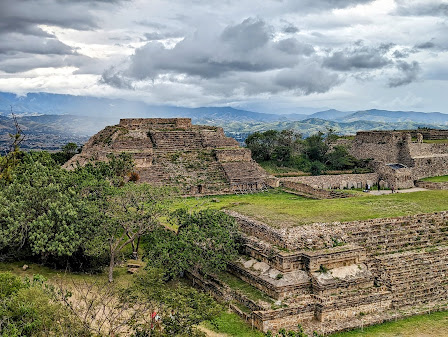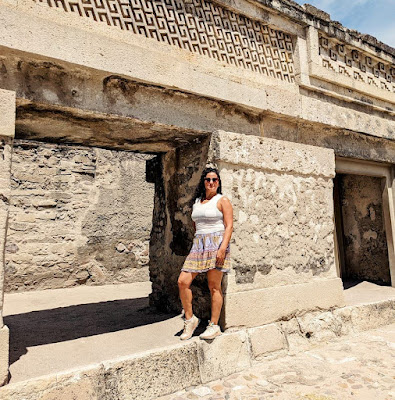Mysticism, Magic, and Mushrooms in the Sacral Chakra of the World
 |
I’ve been feeling the call to the Mexican state of Oaxaca for a very long time. It first came to my attention close to ten years ago when a friend came back from a year abroad in this southern state.
Strolling through the streets in her flowing cotton skirt, oblivious to the impatient waiter's desire to turn the table, it was clear she’d just come back from extended time outside of capitalist America. She had sunkissed skin and enchanted me with tales of seaside women's circles atop cliffs and the lively city of Oaxaca de Juarez, which brimmed with art galleries, foreign film screenings, and cultural festivals. As a bonus, it was one of the safest cities she’d ever traveled to.
I filed the description away in my catalog of desired destinations, noting how convenient and close a destination it was.
It was waiting for me to visit when the time was right. And now that I’ve been here for two months, I can say, I think one could spend years here and never see everything that the state has to offer. I would say that it meets or surpasses my expectations, but truth be told, I didn’t have clear expectations of Oaxaca in my mind. Apart from what my friends told me and the strong intuitive feeling that it would be “my kind of place,” I didn’t do extensive research.
 |
| View from Downtown (Centro) |
So things like seeing peyote and mushroom microdoses for sale in the markets, learning that the world’s widest tree was only twenty minutes away, and stumbling upon performances of shamanic ceremonies in the zocalo were delightful surprises.
From the fascinating mix of indigenous culture — celebrated in grand form through dances, performances, and parades at festival La Guelaguetza, which I was lucky enough to experience my first weeks here — to the ancient temples and ruins of Monte Alban, Mitla, and Yagul to diverse landscapes of pine-covered mountains in the north and rugged beaches in the west, there is so much to see and do.
 |
| Photography from Exhibit at Festival La Guelaguetza |
I one hundred percent understand Oaxaca’s reputation as a creative hub. Arts and crafts of all kinds are central to the culture here. The markets are filled with colorful abstract paintings, ceramic clay pots with grinning animal faces, and woven Zapotec textiles depicting lightning, rain, butterflies, and the cyclical life-death-rebirth nature of the universe. The exquisite gold metalwork found in the tombs of Monte Alban and displayed in the cultural museum speaks of expert hands and a reverence for sublime forms of beauty. Contemporary surrealist, feminist, and political art spills out of galleries and onto city streets.
 |
| Art Gallery in Centro |
Recently, a new friend informed me that some consider this region to be one of the earth's main energy vortexes, similar to Mt. Shasta and the Pyramids of Giza. She described it as the sacral chakra of the earth. While I've read that Peru claims that title (though who can say, really), I wouldn't doubt it because Svadhisthana is sensual and creative, and this region is flush with feminine energy and lush landscapes.
 |
| Hike in the Sierra Norte Mountains |
I was also recently informed that Oaxaca is considered one of the world’s biggest hubs for psychedelic plant medicine. It makes sense — there’s always some peyote, kambo, or mushroom ceremony going on, and just a few hours away is San Jose Del Pacifico, a supposedly hauntingly beautiful mountain town where an abundance of wild shrooms grow.
They’re illegal in Mexico, but the town follows its own laws, and many flock there to pick and eat them, tripping as they watch the mists and clouds roll in from their mountain perch.
In fact, it was Oaxacan María Sabina — known as the “Priestess of Mushrooms” and credited as one of the most famous Mexican healers who ever lived — who is said to have popularized mushrooms in the West. During the 1950s, a Western psychonaut published works about his experiences with Sabina in her village in the Sierra Norte mountains, bringing national attention to her customs. By the 1960s, Aldous Huxley, Alejandro Jodorowsky, Carlos Castaneda, Albert Hoffmann, John Lennon, and Walt Disney had visited her little mountain village to partake in a ceremony with the “holy children."
I'm grateful to be another traveler in the company of these luminaries, plus writers like D.H. Lawrence and Paul Theroux who spent extensive time here, and of course, the scores of other travelers who come here seeking adventure and beauty. Looking forward to making my own discoveries.

Thank you for posting the pictures and information. I have also considered moving to Mexico but not permanently, only for 6 month at a time. I would love to visit and let you be my tour guide. Is that possible?
ReplyDeleteI'm looking for a warm place to move to in the future. Was planning on going back to SE Asia, but this place looks like it's right up my alley, and much closer.
ReplyDelete